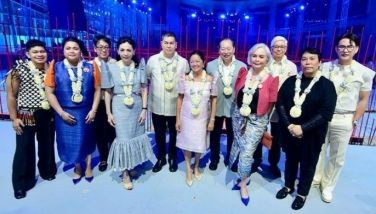Stories of romance in the house of Rizal's first love
Casa de Segunda, the Luz Katigbak ancestral house situated along Calle Rizal in Lipa City, is awash with stories of grandeur and romance.
In the 19th century, the town of Lipa was the sole supplier of coffee to the world and the town’s aristocrats lived much like their Spanish counterparts — in their customs, manners and social forms. Surrounded by the trappings of great prosperity, their homes were said to occupy entire city blocks bounded by gardens and bountiful orchards. They entertained in grand style. Social gatherings were marked by orchestral music and the latest dances from Europe. Tables were laden with fine china, crystal and silver imported from France. Behind the scenes, cooks and servants worked all day long to turn out courses of special Spanish dishes and desserts.
 Love at first intense glance: Jose Rizal was 16 and had just graduated from Ateneo when he first met 14-year-old Segunda Katigbak.
Love at first intense glance: Jose Rizal was 16 and had just graduated from Ateneo when he first met 14-year-old Segunda Katigbak. The Luz and Katigbak clans, the leading families of the town, were not only well-versed in the fine art of living, they were a family of artists, scholars, political leaders — many of them educated in the best schools in Europe.
Casa de Segunda, declared a heritage house by the National Historical Commission, is a reflection of a gentler time and a genteel way of life. Built in the 1880s it is a typical bahay na bato, said to be Spanish in architecture yet essentially a tropical house. Wide windows open to views of flowering trees and allow the cool breezes of Lipa of flow into the second floor living room. Hardwood floors and period furnishings are the dominant features of this home. Traditional lounge chairs with a cane weave back, and rocking chairs situated near the windows were designed for comfort and relaxation. An upper terrace or azotea looks out to mango, peppercorn and alagao trees. In this old stone home once lived a lady who is best known as Jose Rizal’s first love.
Segunda Solis Katigbak was 14 years old when she first met Rizal, and Rizal was 16 and had just graduated from Ateneo. Though their initial meeting was brief, it left an indelible impression on our national hero who from the first instance was smitten with the allure of Segunda. It is often difficult to put into words what draws us to the object of our affection, and for Rizal it was no different. In his diary, Rizal muses: “I don’t know what alluring something was all over her being. She was not the most beautiful woman I have seen but I had never seen one more bewitching or alluring.”
Rizal details their exchanges in Chapter 6 of his diary, Memorias de Un Estudiante de Manila, written in November 16, 1881. So potent were Rizal’s feelings for Segunda that in describing one of their visits, he wrote: “It is true that during the conversation our eyes met, and the most intense glances full of a loving melancholy expression came to enslave my soul forever.”
 Trappings of prosperity: In the 19th century, the town of Lipa was the sole supplier of coffee to the world and the town’s aristocrats lived much like their Spanish counterparts entertained in grand style. Tables were laden with fine china, crystal and silver imported from France.
Trappings of prosperity: In the 19th century, the town of Lipa was the sole supplier of coffee to the world and the town’s aristocrats lived much like their Spanish counterparts entertained in grand style. Tables were laden with fine china, crystal and silver imported from France. Jose Rizal and Segunda Katigbak became better acquainted during Rizal’s weekly visits to La Concordia College in Santa Ana where his sister Olimpia and Segunda were both students. Despite the brief encounters, there was an understanding on Rizal’s part of the sentiments they shared: “Everywhere I heard only talk about our relations and the truth to tell is that we loved each other without having ever declared it clearly except that we understood each other through our glances,” he wrote. Rizal first met Segunda through his sister Olimpia who was a classmate of Segunda at La Concordia College. Segunda’s bother Mariano also happened to be Rizal’s closest friend. Mariano Katigbak and Jose Rizal would often visit their sisters together.
Tensie Bello, a great-granddaughter of Segunda Katigbak recounts some of the tender moments that shed light on the feelings of Rizal for Segunda, “When Segunda would come back from school Rizal would wait for her carriage to pass until it was well on its way and the dust from the horse-drawn carriage had settled.”
Bello also recalls the time when Segunda had given a rose to Rizal before he left for Europe to take up his studies there. Upon his return, Rizal paid a visit to Segunda and showed her the rose he had dried. Martin Tinio Jr. who wrote a chapter for the book, Batangas: Forged in Fire, tells us that, “a smitten Rizal showered the fourteen–year-old lass with flowers, poems and sketches.”
 Heirs of history: Three great-grandaughters of Segunda Katigbak standing in front of a portrait of Manuel Luz: Baby Girl Baluyot Fricke, Lilith Malabanan and Tensie Bello
Heirs of history: Three great-grandaughters of Segunda Katigbak standing in front of a portrait of Manuel Luz: Baby Girl Baluyot Fricke, Lilith Malabanan and Tensie Bello Still the romance would not prosper. Tinio tells us that when the parents of Segunda learned of the infatuation, they hurriedly brought Segunda back to Lipa and tore up her pencil portrait of Rizal. Eventually the letters from Rizal were also destroyed. Their objection to Rizal stemmed from the fact that he did not come from the same town and was not of the same social background. As Tensie Bello points out, it was a family tradition in Lipa for the parents to choose the spouses of their children.
Thus at 16, Segunda was married to Manuel Luz, a wealthy planter and close relative. Still Rizal visited Segunda several times in Lipa as Tinio notes, even playing chess with her husband and when he lost a match, Rizal said, “I not only lost the game but my heart, as well.” In the first European biography of Rizal to be published since 1907, the author Austin Coates puts the romance between Rizal and Segunda Katigbak in context. Of this, he writes: “Its interest lies in the fact that of all his loves it is the only one of which he himself has left a written description.”
Manuel Luz, Segunda’s husband, was, by the accounts of his great-granddaughters, a formidable person and a man of the people who built hospitals, bequeathed plots of land to his servants upon his death, and gave away most of his properties to the poor.
Of the home life of Manuel Luz and Segunda Katigbak, their great-granddaughters, Lilith Malabanan, Tensie Bello and Baby Girl Baluyot Fricke, tell me that it was a very happy one. Though they have been privileged to enjoy the best things life has to offer, they were always mindful of the needs of their servants and the less-fortunate. They are particularly proud of the fact that many of their forebears valued a solid education and went on to become leaders of industry, society and local government. In the 19th century, they helped shape a way of life that we now associate with an age of refinement and gracious living.
 Once upon a time, in genteel Lipa: A storage cabinet, a pair of plant pedestals, a table of rare books, and the ventanillas that run through the living and bedroom areas.
Once upon a time, in genteel Lipa: A storage cabinet, a pair of plant pedestals, a table of rare books, and the ventanillas that run through the living and bedroom areas. Casa de Segunda welcomes students of history who hope to get a rare glimpse into these former days. Lilith Malabanan, whose grandmother, Paz Luz Dimayuga, restored the house in 1956, lives on the premises and often conducts guided tours of the Casa as she draws your attention to old photos, treasured manuscripts copied from the National library, and a volume on life in Batangas and of Batangas society. The Casa today is a shadow of what it must have been yet it remains the oldest house in Lipa that was not destroyed during the Second World War — the only living testament to a time and a way of life long gone. As in the former days, the gardens still yield bountiful fruit trees — mango, santol, avocado, star apple, peppercorn, papaya, calamansi and the alagao — an herb tree known for its curative properties since the heydays of the Casa itself.
Lipa nowadays is a world way from its glory days as an agricultural capital with its languid pace and refined customs. Like all progressive cities, it is marked by industry and commerce that chokes its main streets and narrow roads. Somewhere in this modern-day chaos — in the maze of streets that lead to Casa de Segunda — history waits to be told. Beyond the gates of this heritage home, we learn about an unattainable heiress who captures the heart of a hero, of a time when manners and social mores were everything. And each would yield to the dictates of life and society. As always, the stories of grandeur and romance, from once upon a time, are still the most fascinating and seductive, however it all turns out.
 Those lacey days: A canopied bed dressed in lace, favored by the Philippine elite.
Those lacey days: A canopied bed dressed in lace, favored by the Philippine elite. * * *
Your comments are welcome. Please e-mail tonettemartel @gmail.com. For further information on Casa de Segunda, call (043) 756-5970.















